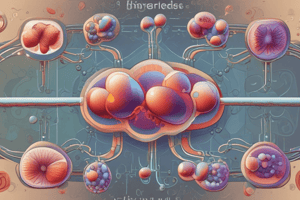Podcast
Questions and Answers
Which of the following correctly describes the structure of a triglyceride?
Which of the following correctly describes the structure of a triglyceride?
- A glycerol molecule with two saturated and one unsaturated fatty acid. (correct)
- A glycerol molecule bonded to three different fatty acids. (correct)
- A single glycerol molecule bonded to one fatty acid.
- A glycerol molecule with three identical saturated fatty acids.
Why are unsaturated fats typically liquid at room temperature?
Why are unsaturated fats typically liquid at room temperature?
- They have a higher specific gravity than saturated fats.
- They contain more carbon atoms than saturated fats.
- They are made exclusively from animal sources.
- They have double bonds causing kinks in their structure. (correct)
What is the primary difference between saturated and unsaturated fatty acids?
What is the primary difference between saturated and unsaturated fatty acids?
- Saturated fats can dissolve in water, while unsaturated cannot.
- Saturated fats have the maximum number of hydrogen atoms bonded, whereas unsaturated fats do not. (correct)
- Saturated fats contain double bonds between carbon atoms, while unsaturated do not.
- Saturated fats are typically derived from plant sources, while unsaturated come from animals.
In the context of fatty acids, what does the term 'kinks' refer to?
In the context of fatty acids, what does the term 'kinks' refer to?
What health effects are commonly associated with trans fats?
What health effects are commonly associated with trans fats?
Which fatty acid structure is primarily found in fats and contributes to their solid state at room temperature?
Which fatty acid structure is primarily found in fats and contributes to their solid state at room temperature?
What is a significant health concern associated with trans fats found in some fats?
What is a significant health concern associated with trans fats found in some fats?
Which type of fat is characterized by having higher melting points due to its fatty acid composition?
Which type of fat is characterized by having higher melting points due to its fatty acid composition?
Cis and trans bonds in fatty acids affect which property most significantly?
Cis and trans bonds in fatty acids affect which property most significantly?
What is the primary reason for the differences in physical properties between fats and fixed oils?
What is the primary reason for the differences in physical properties between fats and fixed oils?
Flashcards are hidden until you start studying
Study Notes
Fats and Oils
- Liquid at 15.5 – 16.5 °C is classified as fixed oil; solid or semi-solid above this temperature is termed fat.
- Both fats and oils have a specific gravity of less than 1, allowing them to float in water.
Composition of Fats and Oils
- Composed of glycerol (a triol with a hydroxyl group on each carbon) and three fatty acids, forming triglycerides.
- Triglycerides can have varying combinations of fatty acids (R1, R2, R3), making them unique in structure.
Fatty Acids
- Fatty acids consist of a hydrophobic hydrocarbon "tail" and a hydrophilic carboxyl "head."
- When fatty acids form soaps, their tails emulsify and help remove oily substances.
Saturated vs. Unsaturated Fats
- Saturated fats contain maximum hydrogen, leading to straight hydrocarbon chains that pack tightly, thus solid at room temperature.
- Unsaturated fats contain double bonds, resulting in kinks that prevent close packing, keeping them liquid at room temperature.
Comparison: Fats vs. Fixed Oils
- Fats mainly consist of saturated fatty acids, are solid at room temperature, and have higher melting points.
- Fixed oils primarily contain unsaturated fatty acids, remain liquid at room temperature, and possess lower melting points.
Definition and Characteristics of Fixed Oils
- Fixed oils (or non-volatile oils) are glycerides of fatty acids, stable at room temperature, and non-volatile.
- Comprised mainly of triglycerides; insoluble in water but soluble in organic solvents.
Sources and Extraction of Fixed Oils
- Extracted using methods like cold pressing or solvent extraction.
- Common sources include various plant seeds (sunflower, sesame), fruits (olive, avocado), and animal fats (lard, tallow).
Examples of Fixed Oils
- Notable examples include castor oil, almond oil, olive oil, cottonseed oil, peanut oil, corn oil, soybean oil, safflower oil, sesame oil, and cocoa butter.
Chemical Composition of Fixed Oils
- Fixed oils consist primarily of triglycerides, with properties influenced by the type of fatty acids present (saturated, monounsaturated, polyunsaturated).
Lipids Overview
- Lipids are organic compounds characterized by their solubility in nonpolar organic solvents and insolubility in water.
- Include fixed oils, fats, and waxes; serve as structural components of membranes and energy reserves.
- Function as carriers for vitamins and hormones and play crucial roles in biological processes.
Waxes
- Waxes are esters of long-chain fatty acids and higher molecular weight alcohols, differing chemically from fats and oils.
Learning Outcomes
- Understand and describe sources and occurrences of fixed oils, fats, and waxes in nature.
- Identify extraction methods for obtaining these substances.
- Evaluate physical characteristics and pharmaceutical significance of selected oils in medicinal use (e.g., castor oil, olive oil).
Studying That Suits You
Use AI to generate personalized quizzes and flashcards to suit your learning preferences.




